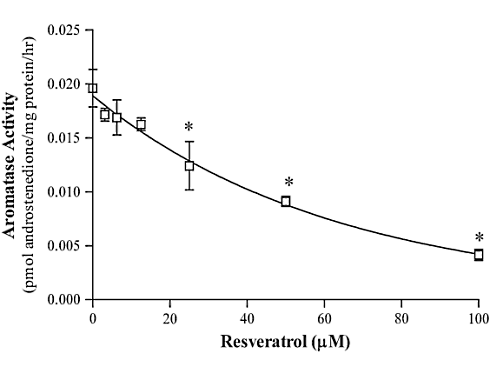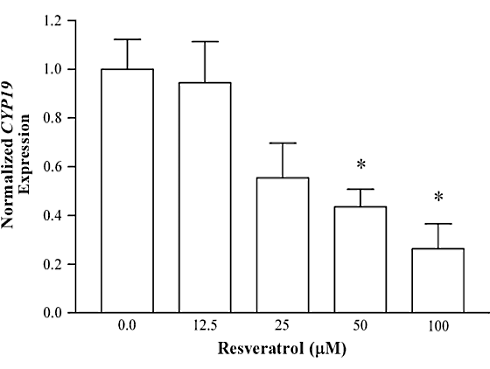Resveratrol is an anti-oestrogen
Resveratrol, a compound found in the skin of red grapes, has an anti-oestrogenic effect. According to an in-vitro study done at the Chinese University of Hong Kong in 2006, the effect is so strong that high ??? but not impossible ??? doses can protect women against breast cancer. And, we'd add, it can help athletes to lower their estradiol levels.
The researchers performed experiments using the human breast cancer cell SK-BR-3 and the genetically modified MCF-7aro cell. MCF-7 is also a human breast cancer cell. The researchers used a version of the cell which had extra genes attached, so that it could make aromatase. Aromatase is the enzyme that transforms testosterone and androstenedione into estradiol.
There are two aspects to the relationship between estradiol and cancer. Estradiol can change into analogues (the 4- and 16-hydroxy analogues), and these can change healthy cells into cancer cells. In addition, many brease cancer cells have receptors for estradiol.

The higher the estradiol level, the faster the cells grow and the less chance the body's immune system has to clear them out of the body.
The Chinese wanted to know whether resveratrol [structural formula shown below] is capable of inhibiting this process, thus reducing the chances of developing hormone-related cancer. From epidemiological studies they already knew that the small amounts of resveratrol that people consume by eating grapes, peanuts and berries help reduce the risk of breast cancer. [Eur J Cancer Prev. 2005 Apr; 14(2): 139-42.] They also knew that, in test tubes, red-grape extracts prevented aromatase from doing its work properly. [Cancer Res. 2003 Dec 1; 63(23): 8516-22.]
When the Chinese exposed SK-BR-3 cells to resveratrol they saw that the higher the concentration of resveratrol, the less active the aromatase became. The first figure below shows this. The second figure below shows how resveratrol reduced the aromatase production in the same cell type.



The figure above shows how resveratrol delayed the growth of MCF-7-aro cells, which had also been exposed to testosterone. The higher the resveratrol concentration, the greater the effect.
The figures also show that resveratrol has a noticeable effect at a concentration of several tens of micromoles. That's a dose that you can achieve with supplements, the researchers conclude from a study done at the State University of New Jersey. [J Agric Food Chem. 2004 Feb 25; 52(4): 935-42.] In that [human] study, an intake of 1mg resveratrol per kg bodyweight resulted in a resveratrol concentration in the blood of 40 micromoles.

If you say 'anti-oestrogen' to strength athletes, they automatically think ???more testosterone'. This association is correct, if resveratrol is the substance in question, according to an animal study done at the Universitat de Barcelona, which is where we found the figure shown above. [J Nutr. 2005 Apr; 135(4): 757-60.]
It shows what happens to testosterone and sperm production if you give mice 20 mg resveratrol per kg bodyweight for 90 days in a row. A conservative estimate of the equivalent dose for humans is 2 mg per kg bodyweight.
The health-promoting effect of resveratrol may be even bigger than the Chinese study suggests. Cell studies have shown that resveratrol also inhibits the production of gene-toxic estradiol analogues [Cancer Prev Res (Phila). 2008 Jul;1(2):135-45.] and prevents damage to genetic material [Free Radic Biol Med. 2008 Jul 15; 45(2): 136-45.].
Source:
Toxicol Sci. 2006 Jul; 92(1): 71-7.
Resveratrol, a compound found in the skin of red grapes, has an anti-oestrogenic effect. According to an in-vitro study done at the Chinese University of Hong Kong in 2006, the effect is so strong that high ??? but not impossible ??? doses can protect women against breast cancer. And, we'd add, it can help athletes to lower their estradiol levels.
The researchers performed experiments using the human breast cancer cell SK-BR-3 and the genetically modified MCF-7aro cell. MCF-7 is also a human breast cancer cell. The researchers used a version of the cell which had extra genes attached, so that it could make aromatase. Aromatase is the enzyme that transforms testosterone and androstenedione into estradiol.
There are two aspects to the relationship between estradiol and cancer. Estradiol can change into analogues (the 4- and 16-hydroxy analogues), and these can change healthy cells into cancer cells. In addition, many brease cancer cells have receptors for estradiol.

The higher the estradiol level, the faster the cells grow and the less chance the body's immune system has to clear them out of the body.
The Chinese wanted to know whether resveratrol [structural formula shown below] is capable of inhibiting this process, thus reducing the chances of developing hormone-related cancer. From epidemiological studies they already knew that the small amounts of resveratrol that people consume by eating grapes, peanuts and berries help reduce the risk of breast cancer. [Eur J Cancer Prev. 2005 Apr; 14(2): 139-42.] They also knew that, in test tubes, red-grape extracts prevented aromatase from doing its work properly. [Cancer Res. 2003 Dec 1; 63(23): 8516-22.]
When the Chinese exposed SK-BR-3 cells to resveratrol they saw that the higher the concentration of resveratrol, the less active the aromatase became. The first figure below shows this. The second figure below shows how resveratrol reduced the aromatase production in the same cell type.



The figure above shows how resveratrol delayed the growth of MCF-7-aro cells, which had also been exposed to testosterone. The higher the resveratrol concentration, the greater the effect.
The figures also show that resveratrol has a noticeable effect at a concentration of several tens of micromoles. That's a dose that you can achieve with supplements, the researchers conclude from a study done at the State University of New Jersey. [J Agric Food Chem. 2004 Feb 25; 52(4): 935-42.] In that [human] study, an intake of 1mg resveratrol per kg bodyweight resulted in a resveratrol concentration in the blood of 40 micromoles.

If you say 'anti-oestrogen' to strength athletes, they automatically think ???more testosterone'. This association is correct, if resveratrol is the substance in question, according to an animal study done at the Universitat de Barcelona, which is where we found the figure shown above. [J Nutr. 2005 Apr; 135(4): 757-60.]
It shows what happens to testosterone and sperm production if you give mice 20 mg resveratrol per kg bodyweight for 90 days in a row. A conservative estimate of the equivalent dose for humans is 2 mg per kg bodyweight.
The health-promoting effect of resveratrol may be even bigger than the Chinese study suggests. Cell studies have shown that resveratrol also inhibits the production of gene-toxic estradiol analogues [Cancer Prev Res (Phila). 2008 Jul;1(2):135-45.] and prevents damage to genetic material [Free Radic Biol Med. 2008 Jul 15; 45(2): 136-45.].
Source:
Toxicol Sci. 2006 Jul; 92(1): 71-7.


